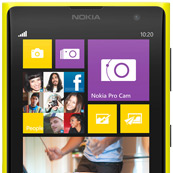Introduction
Although there have been other “PureView” models from the firm, the 41-Mpix Nokia Lumia 1020 is the successor to the rightly popular Nokia 808 PureView, a high-end smartphone that sits in first place in our mobile rankings with a score of 77 points. The firm may have dropped the Symbian OS and PureView moniker from the Lumia 1020, but expectations are high.
The downsampling of such large files from the 41-Mpix sensor worked well with the Nokia 808 PureView, resulting in detailed images with low noise, and that same strategy has been applied to the Lumia 1020. At first sight, though, with an overall DxOMark Mobile score of 74 points, the Windows-powered smartphone doesn’t appear to perform quite as well as its predecessor.
The Nokia Lumia 1020 comes in fourth overall, behind the rival Samsung Galaxy S4 and Apple iPhone 5S, but a closer look at the scores reveals that the Lumia, in fact, ranks in second place for stills with a score of 79 points (just two points behind its sibling). What is somewhat disappointing is that the camera sits in a lowly 12th place for video, which obviously pulls the Lumia 1020 down in the overall rankings.
Underneath the sleek-looking shell, the camera actually retains the PureView technology, including a 25mm-equivalent f/2.2 lens with optical image stabilization and the crucial downsampling of output from the 41-Mpix BSI CMOS sensor. This is used for both the 2.7x digital zoom, while also limiting the image output to around 5 Mpix, the advantage being reducing noise and keeping file sizes reasonably compact for sharing.
In summary then, the Nokia Lumia 1020 is one of the best cameraphones for stills, but its video performance could be improved, which lowers its overall ranking.
In fact, under low-light conditions, the Lumia 1020 outperforms rivals, producing still images with low noise and detail preservation that are simply the best we’ve ever seen from a smartphone.
Compared with the more recent Apple iPhone 5S, we can see that while Apple is getting the most from its existing technology, they appear closer to their technical limit than Nokia is with their Lumia 1020.
Nokia’s PureView technology, combined with the very high pixel count of the sensor, results in the Lumia 1020 having the lowest noise levels we’ve seen, while also coming first for detail retention in both dim and bright light levels.
We were also very impressed by the results of the built-in flash. Images revealed accurate exposure but also good color (and white balance), as well as the characteristic low noise and highly-detailed imagery already mentioned.
Nokia Lumia 1020 compared with Apple iPHone 5S at 20 Lux.
Nokia Lumia 1020 compared with Apple iPHone 5S at 5 Lux.
Some areas of still capture could be improved, though. Our sample images revealed high levels of color shading, particularly with indoor lighting, but also outdoors as well.
And some outdoor scenes revealed a blue tint when compared to images captured at the same time with the rival iPhone 5S. Without lens hoods, cameraphones like this are particularly prone to lens flare, which lowers image contrast, and the Lumia 1020 is no exception to that.
While the Lumia 1020 retains high detail during video capture in bright light, video isn’t generally a strong point for the Nokia Lumia 1020. Strong row noise and visible blocking artifacts were noticeable in indoor scenes and the autofocus was prone to oscillating (hunting back and forth) when refocusing.
During our tests we also observed that the Lumia was unable to stabilize the image during walking, and separately, the system overcompensated when steadied on tripod.
Photo Pros
- Excellent detail preservation both in low and bright light conditions.
- Very low noise level with no chroma component.
- Accurate exposure in extreme low light conditions (where other camera phones fail).
- Pleasing photo rendering with flash: good exposure, color, white balance, texture and noise.
- Fast and precise autofocus.
Video Pros
- Good texture preservation in bright lighting conditions.
Photo Cons
- Strong color shading with indoor lighting and occasionally outdoors.
- In low light conditions, overly long exposure times lead to motion blur.
- Slightly tendency to underexposure outdoors.
- Occasional white balance inaccuracies outdoors or with fluorescent lightings.
- Substantial flare noticeable in presence of a strong light source.
Video Cons
- Strong row noise evident
- Visible blocking artifacts
- Walking movements remain uncorrected by the video stabilization
- Autofocus oscillations are visible during refocusing.
- Over-correction of video stabilization when steadied (on a tripod).








DXOMARK encourages its readers to share comments on the articles. To read or post comments, Disqus cookies are required. Change your Cookies Preferences and read more about our Comment Policy.